Saturday, August 07, 2004
Æ sestertius, Gallienus, Rome, Göbl 426v
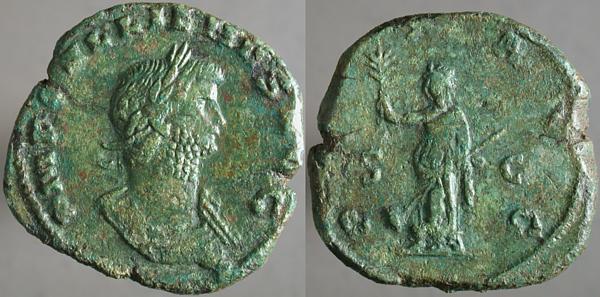
IMP GALLIENVS AVG, Laureate cuirassed bust right | PAX AVG, Pax standing facing, head left, holding branch left and long scepter transverse. S_C across fields.
The big bronze sestertius almost certainly cost more to produce than the thoroughly debased antonianus, which was tariffed at eight times its worth. The sestertius, dupondius, and as were discontinued soon after Gallienus became sole emperor. This is an example of a late issue sestertius.
Friday, August 06, 2004
Æ31, Tabae in Caria, Gallienus, BMC 103
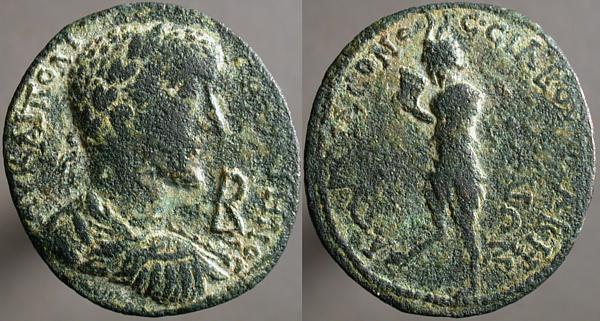
ΑV ΚΑΙ ΠΟ ΛΙ ΓΑΛΛΙΗΝΟC, Laureate draped cuirassed bust right, large B before | Α[ΡΧ ΙΑ]CΟΝΟC CΙΛΒΟV ΤΑΒΗ / ΝΩΝ, Goat-legged horned Pan, dancing left, playing syrinx.
As far as I can tell, Tabae is still inhabited, and still retains its ancient name. (Link is to a travel company that wants you to visit Turkey, but I couldn't find a better photo of the ruins.)
Pan doesn't show up much on Roman-era coins, certainly not this late in the game, but here he is. Pan sort of invented "mad, bad, and dangerous to know."
Some months I run past my collecting budget early, some months I have a bit of money left. This one was purchased with July's excess.
And "don't forget your goat leggings!"
Thursday, August 05, 2004
Billon antoninianus, Valerian, Viminacium, Göbl 793d
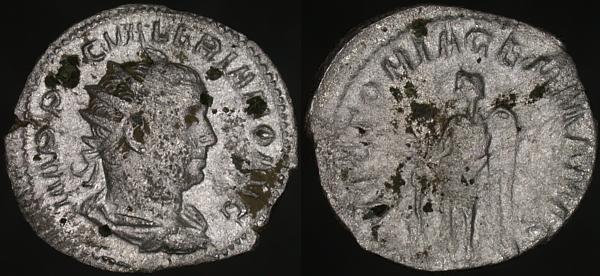
IMP P LIC VALERIANO AVG, Radiate draped cuirassed bust right | VICTORIA GERMANICA, Victoria standing facing, head left, holding palm to right, holding shield left. Tiny captive at feet left.
Only Viminacium and Cyzikus minted both imperial and provincial coins for Valerian or Gallienus.
There's a series of three imperials from Viminacium that share this obverse legend, which is also used on at least one provincial issue of year XIV of this colony (253-254) the first year of their reign.
These imperials apparently are also from that year and are presumably the first imperial emission from this mint, which also continued issuing provincial bronze until at least year XVI, and imperial antoniniani for some years beyond that.
Wednesday, August 04, 2004
Æ as, Caligula, Rome, 37-41 CE, RIC 38
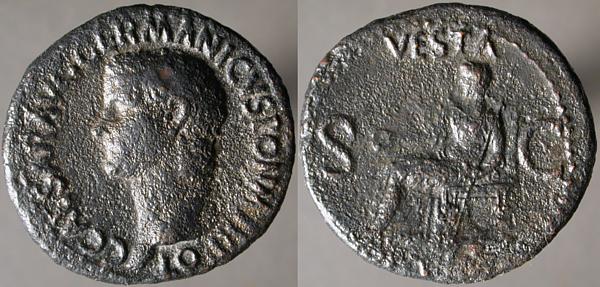
C CAESAR AVG GERMANICVS PON M TR POT, Bare head left | VESTA, Vesta seated left, holding patera left and long transverse scepter. S C flanking.
Gaius Caesar Augustus Germanicus, remembered today as Caligula.
For a man so famously infamous, we know very little about Caligula, being forced to rely on the writings of his enemies, who had every reason to exaggerate his personal shortcomings, and to invent new ones as required.
Probably he was more a murderous, stuck-up little perv, altogether smaller than the monster he is in popular thought. Caligula wasn't so much of a much until PBS rebroadcast a BBC 1976 miniseries. It's no coincidence that when Bugs Bunny needs a villainous Roman emperor, it's Nero, not Caligula, that's portrayed. (Admittedly, it's Laughton's Nero from the 1932 Sign of the Cross, and if the abandoned 1937 I, Claudius had been a success Caligula might have had his innings 40 years early. But I digress.)
(Ummm. Suddenly, everyone was run over by a chariot.)
Caligula came to power in March, 37 CE on the death of his grand-uncle, Tiberius, and made few friends at Rome or in the provinces.
On January 24, 41, after a night at the theater (Our Cilician Cousin), a conspiracy of his praetorians, backed by Senators and others, gave him the old dagger-up-the-toga which had been practiced on a dictator by the Senate some years previously. First applied to an Augustus now, it set a precedent upon which Rome would depend for years to come.
By the next day his uncle, Tiberius Claudius Nero Germanicus, was emperor.
Tuesday, August 03, 2004
"taking guided tours around the town"
Æ24, Alexandria Troas, Gallienus, Bellinger A465
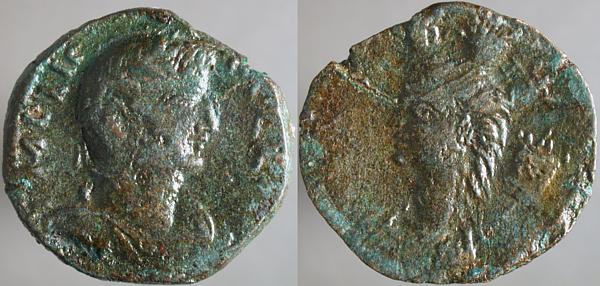
IMP LIC [...]LL[...], Laureate draped cuirassed bust right | [...], Turreted draped bust of Tyche left with vexillum behind.
Beside the 21mm bronzes of Gallienus for this city (about the size of a US nickel), there are a few varieties of larger 24mm coins (about the size of a US quarter), in a wilder style.
Of them, and referring back to the smaller coins, which he attributes to the time before Valerian's capture by the Sassanian Persian king Shapur, Alfred R. Bellinger, in his 1960 Troy the Coins, says:
The foregoing coins form a homogenous body in style and fabric. Father and son and son's wife use essentially the same types and there are no items which we have any evidence for attributing to Gallienus alone after his father's capture by the Persians in 260. But there are other coins of Gallienus of totally different appearance. The reverse type is the turreted head of Tyche which had been used an an obverse type throughout the semi-autonomous series but which had never appeared in conjunction with the imperial portrait. Both types are large and slovenly, in sharp contrast with the not unattractive dies of Gallienus' other issues. The obverse legend is meant to be IMP GALLIENV or IMP LIC GALL or IMP C LIC GALL, but is so weakly cut as to be generally illegible. The reverse legend is COL AV TROA or TROAS (and once ALEX TR) but the first two titles are relegated to the vexillum behind Tyche's head (as they appear on the obverse Tyche where the name of the city is clearly displayed on the reverse). Finally the size of the flans (23-25 mm.) shows that they were intended for a different denomination or for a radical increase in the size of the as. That the second possibility is the true one is shown by the fraction which has a modification of the old familiar tripod type of the quadrans but is as large as the other asses of Gallienus. All this makes it certain that we have to do with the issues of another period which, of course, must be that of Gallienus' sole reign from 260 to 268. But it was at this time that Gallienus closed most of the civic mints, forcing the cities to use the debased Antoniniani with which he flooded the Roman world. It is suggested that the step was taken because the bullion value of bronze was greater than its face value in terms of Antoniniani. It is also possible that the government was unwilling or unable to share any profit of the manufacture with the cities. The hypotheses may be mutually exclusive but, in either case, it is hard to see why Gallienus should suddenly produce larger coins of greater intrinsic value though the theoretical denomination was the same—coins, moreover, with a type of the city's Tyche that would seem rather to announce a concession to the municipality than a restriction of its rights. It is also hard to see why the disaster to Valerian should have produced so complete a collapse in the workmanship of this remote mint. If the new emissions follow directly from the old why are they so very much worse? Indeed, why are they so much worse if there was an interval? And then, when did Gallienus close the mint?
The question is unavoidable whether these are in fact official issues. I suggest that they are not; that they were made after the official closing of the mint but while Gallienus was still emperor; that they were intended to provide the townspeople with bronze coins such as they were accustomed to use and would use again if they could instead of the imperial so-called silver. The city itself could hardly presume to take such action, but there might be private citizens who would risk official displeasure if the demand for bronze money seemed great enough. It might well be, in that case, that the artisans whom they could induce to do their illicit work could perform no better than the cutters of these dies. A phenomenon at Parium may be related, (he refers to another page in the book – Ed). Why the experimental coins were made larger I do not know, unless with some idea that they would be more impressive and so have a wider circulation. But the size of the coins is a problem no matter who issued them. Since the number of specimens preserved is considerable the experiment must have been successful for a time.
Which is some interesting speculation, but a bit short of supporting facts. I'll be keeping my eyes open to see if anyone's challenged it in the nearly 45 years since it was originally published.
Monday, August 02, 2004
Atlas Line, bad faith, etc
Billon antoninianus, Gallienus, Köln, Göbl 879d
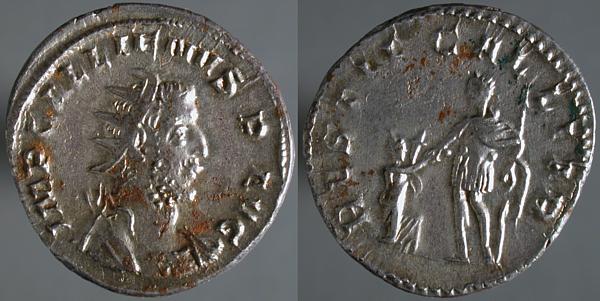
IMP GALLIENVS P AVG, Radiate cuirassed bust right | RESTIT GALLIAR, Gallienus in military garb, right, raising kneeling Gallia
Similar to the Thursday's coin, but issued some time later, this features an abbreviated reverse legend, and a less ornate bust.
Better preserved, too.
It shows a bit of history that's seen on most of his coins, but that we wouldn't have otherwise known: Gallienus's beard was quite curly.
See, history can be trivial!
Sunday, August 01, 2004
Æ24, Aezanis in Phrygia, quasi-autonomous, SNG von Aulock 3339
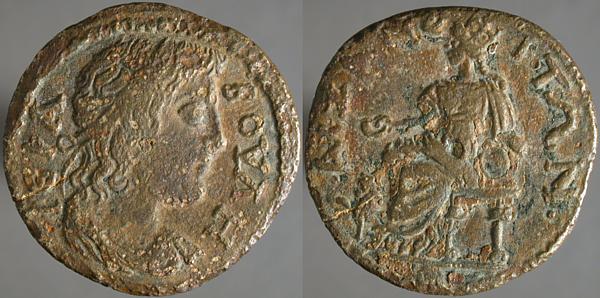
ΙΕΡΑ ΒΟVΛΗ, Diademed draped bust of Boule right | ΑΙΖΑΝΕ_ΙΤΩΝ,Kybele, turreted, seated left on throne, holding patera left, elbow resting on tympanum right. Lion at feet left.
A quasi-autonomous coin from the time of Gallienus.
Aezanis in Phrygia? Look here and here.
Boule? here and here.
quasi-autonomous? In February, I said:
There remains some confusion about the status of quasi-autonomous coins like this; those that do not display the name or image of the Emperor or any member of his family. Athens under Roman rule, in particular, never issued anything but quasi-autonomous coins, and it has been believed that this was a privilege, granted and withdrawn at the Emperor's whim. Lately, that belief has fallen out of fashion, although there was clearly something special about Athens.Other than a spelling error I just cleaned up, I'm sticking with that.

